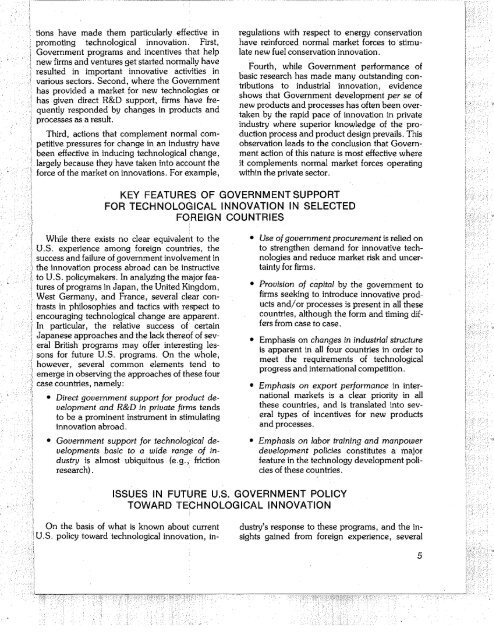Office of Technology Assessment - Bayhdolecentral
Office of Technology Assessment - Bayhdolecentral
Office of Technology Assessment - Bayhdolecentral
Create successful ePaper yourself
Turn your PDF publications into a flip-book with our unique Google optimized e-Paper software.
tions have made them particularly effective in<br />
promoting technological innovation. First,<br />
Government programs and incentives that help<br />
new firms and ventures get started normally have<br />
resulted in important innovative activities in<br />
various sectors. Second, where the Government<br />
has provided a market for new technologies or<br />
has given direct R&D support, firms have frequently<br />
responded by changes in products and<br />
processes as a result.<br />
Third, actions that complement normal competitive<br />
pressures for change in an industry have<br />
been effective in inducing technological change,<br />
largely because they have taken into account the<br />
force <strong>of</strong> the market on innovations. For example,<br />
regulations with respect to energy conservation<br />
have reinforced normal market forces to stimulate<br />
new fuel conservation innovation.<br />
Fourth, while Government performance <strong>of</strong><br />
basic research has made many outstanding contributions<br />
to industrial innovation, evidence<br />
shows that Government development per se <strong>of</strong><br />
new products and processes has <strong>of</strong>ten been overtaken<br />
by the rapid pace <strong>of</strong> innovation in private<br />
industry where superior knowledge <strong>of</strong> the production<br />
process and product design prevails. This<br />
observation leads to the conclusion that Government<br />
action <strong>of</strong> this nature is most effective where<br />
it complements normal market forces operating<br />
within the private sector.<br />
KEY FEATURES OF GOVERNMENT SUPPORT<br />
FOR TECHNOLOGICAL INNOVATION IN SELECTED<br />
FOREIGN COUNTRIES<br />
While there exists no clear equivalent to the<br />
U.S. experience among foreign countries, the<br />
success and failure <strong>of</strong> government involvement in<br />
the innovation process abroad can be instructive<br />
to U.S. policymakers. In analyzing the major features<br />
<strong>of</strong> programs in Japan, the United Kingdom,<br />
West Germany, and France, several clear contrasts<br />
in philosophies and tactics with respect to<br />
encouraging technological change are apparent.<br />
In particular, the relative success <strong>of</strong> certain<br />
Japanese approaches and the lack there<strong>of</strong> <strong>of</strong> several<br />
British programs may <strong>of</strong>fer interesting lessons<br />
for future U.S. programs. On the whole,<br />
however, several common elements tend to<br />
emerge in observing the approaches <strong>of</strong> these four<br />
case countries, namely:<br />
• Direct government support for product development<br />
and R&D in private firms tends<br />
to be a prominent instrument in stimulating<br />
innovation abroad.<br />
• Government support for technological developments<br />
basic to a wide range <strong>of</strong> industry<br />
is almost ubiquitous (e.g., friction<br />
research) .<br />
• Use <strong>of</strong>government procurement is relied on<br />
to strengthen demand for innovative technologies<br />
and reduce market risk and uncertainty<br />
for firms.<br />
• Provision <strong>of</strong> capital by the government to<br />
firms seeking to introduce innovative products<br />
and/or processes is present in all these<br />
countries, although the form and timing differs<br />
from case to case.<br />
• Emphasis on changes in industrial structure<br />
is apparent in all four countries in order to<br />
meet the requirements <strong>of</strong> technological<br />
progress and international competition.<br />
• Emphasis on export performance in international<br />
markets is a clear priority in all<br />
these countries, and is translated into several<br />
types <strong>of</strong> incentives for new products<br />
and processes.<br />
• Emphasis on labor training and manpower<br />
development policies constitutes a major<br />
feature in the technology development policies<br />
<strong>of</strong> these countries.<br />
ISSUES IN FUTURE U.S. GOVERNMENT POLICY<br />
TOWARD TECHNOLOGICAL INNOVATION<br />
On the basis <strong>of</strong> what is known about current<br />
U.S. policy toward technological innovation, in-<br />
dustry's response to these programs, and the insights<br />
gained from foreign experience, several<br />
5
















